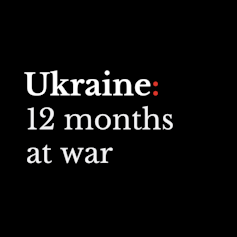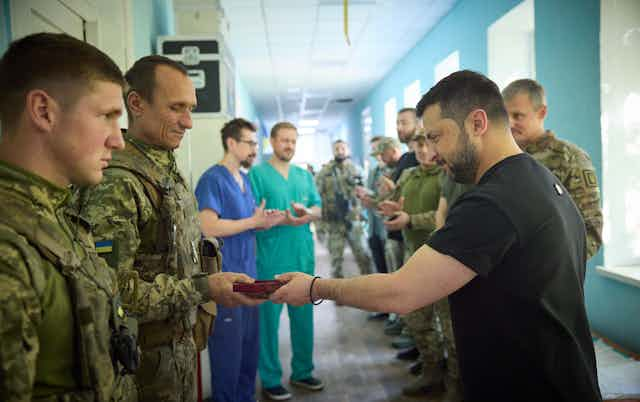Google the words “Ukraine counteroffensive” and the adverb you will most commonly find associated with them is “slowly”. The popular misconception in the months leading up to the launch of Ukraine’s summer push was that, like last autumn’s lightning counter-attacks around Kherson in the south and Kharkiv in the north-east – which regained significant amounts of territory – this summer’s campaign would progress just as quickly.
But what many of us hadn’t taken into account was that Russian forces – who had the same broad awareness of Ukraine’s intentions for a counteroffensive as anyone who reads the news – had spent months preparing its defences. Satellite imagery has revealed hundreds of miles of front defended by minefields, barricades, “dragon’s teeth” obstacles and anti-tank ditches.
But if the progress of Ukraine’s forces in reclaiming territory has been slow, it has been steady, writes Veronika Poniscjakova, who researches and teaches military strategy at the University of Portsmouth. And for the past few weeks, it has conducted raids across the Dnipro river in the south of the country. If Ukraine can establish a significant bridgehead on the eastern side of the river, it could open up the way for a significant push southwards through Russian-held territory. And that, she writes, could be a game-changer which would allow Kyiv’s counteroffensive to significantly pick up the pace.
This could be important, as there is growing evidence that several of Ukraine’s western allies are growing impatient about the amounts of their money this war is consuming in the middle of a cost of living crisis. Should the war continue into 2024 (which appears likely) and beyond (which is very possible), US Republican presidential frontrunner Donald Trump has as good as declared that if elected he will cut off funding to Ukraine’s war effort. But closer at hand is a general election in Slovakia next month, where the frontrunner, Robert Fico, is outspokenly pro-Kremlin and has often referred to “Ukrainian fascists” who started the war with Ukraine. He wants to halt any aid from his country if elected.

Since Vladimir Putin sent his war machine into Ukraine on February 24 2022, The Conversation has called upon some of the leading experts in international security, geopolitics and military tactics to help our readers understand the big issues. You can also subscribe to our fortnightly recap of expert analysis of the conflict in Ukraine.
There’s a groundswell of support for a ceasefire, or armistice, which would at least end the shooting, at least for now. But that’s not really a viable solution, according to Nick Baron, an associate professor in history at the University of Nottingham and his co-author Stephan Rindlisbacher, an academic research fellow for the Center for Interdisciplinary Polish Studies at the European University Viadrina. For a start, it would give Russia the breathing space to resupply and train more troops. And then there is the status of the many regions that are divided between Ukrainian and Russian occupation, which would make for a logistical and legal nightmare. Baron and Rindlisbacher call on history to explain why this would cause so many problems.
Read more: Ukraine war: why a ceasefire based on partition of territory won't work
Jeddah summit considers Zelensky peace plan
Ukrainian president, Volodymyr Zelensky, has always been absolutely clear that a ceasefire won’t do and that nothing short of a complete Russian withdrawal from Ukrainian soil and a pledge to respect the pre-2014 borders would be acceptable for Kyiv. He also wants all prisoners to be exchanged and a mechanism to ensure accountability for war crimes.
As Stefan Wolff, professor of international relations at the University of Birmingham, writes, Zelensky had the chance to table his plan in front of senior representatives from a large and diverse collection of countries at a summit in Jeddah earlier in the month. What’s significant about this, writes Wolff, is that among the 40 countries present were a number who have previously not supported Ukraine.

Four of the five Brics members (Brazil, India, China and South Africa – but not Russia) were present as was US national security adviser, Jake Sullivan. No joint declaration was reached, but given the participants, this is not surprising. But getting into the same room as some heavy hitters from these countries was a significant achievement in itself.
China’s representative at the Jeddah summit was its special representative of the Chinese government on Eurasian affairs, Li Hui, who has acted as Xi Jinping’s adviser on Ukraine through the conflict. He and his political masters in Beijing will be weighing up the course and consequences of this war very carefully with a view to China’s own territorial ambitions vis-a-vis Taiwan.
Peter Rutland, professor of government at Wesleyan University in New England, offers a precis of issues raised by Russia’s invasion of Ukraine that could influence Beijing’s thinking for or against going ahead with a full-scale invasion of its island neighbour.
Read more: War in Ukraine is a warning to China of the risks in attacking Taiwan
A new type of war
A big feature of the conflict has been the increasing use, and sophistication, of unmanned aerial vehicles (UAVs) – or, in common parlance, drones. It’s not the first war where drones have been used – Britain tested a UAV in the first world war in the shape of a small radio-controlled aircraft called an Aerial Target was first tested in March 1917 while the American aerial torpedo known as the Kettering Bug first flew in October 1918 (neither were actually used operationally in the event). Since the turn of the century, they’ve been used in several wars, but in Ukraine, the use of drones for both reconnaissance and as offensive weapons has increased exponentially.

David Dunn, professor of international politics at the University of Birmingham, writing with Stefan Wolff, explains how the use of drones developed and built by the Ukrainians themselves has allowed Kyiv to attack targets inside Russia itself – even in recent months in attacks on Moscow. This is significant because in most cases Ukraine’s western allies have made it a condition of supplying weapons that they aren’t used against targets in Russia. Drones have given Ukraine the ability to bring the war beyond the frontlines to the very streets of Russia itself.
Read more: Ukraine war: drones are changing the conflict – both on the frontline and beyond
Making western firms pay for doing business in Russia
Not all western companies have ceased to do business in Russia, despite the invasion of Ukraine and the discovery of what appear to be egregious war crimes committed during the conflict. Some have stayed put and continue to ply their trade – you can still buy a Cornetto, made by Unilever, for example. Since the war started, the Kyiv School of Economics estimates that western companies still operating in Russia made over US$213.9 billion (£168.2 billion) in revenues in 2022.
It’s not just the US$$3.5 billion in taxes on profits paid to Russia – the income taxes and social contributions of their employees, as well as the VAT on their sales, feed into Russia’s budget too. Unilever says that “exiting is not straightforward” and that it has halted all advertising spending and other capital flows into and out of Russia. That may be the case – and there is no sense that the company is behaving improperly, but as Renaud Foucart, a senior lecturer in economics at Lancaster University Management School writes, there is a way to make these companies pay the cost they impose on the world while acknowledging the impossibility of making them completely leave Russia.
Homes away from home
When the war began and the number of Ukrainian civilians pouring across the borders in search of a haven mounted, the response in most cases was heartwarming. Millions found refuge in surrounding countries and many have transited further afield to countries such as the UK where schemes have been set up to find them homes for the duration of the conflict.
So, 18 months on, how fares the Homes for Ukraine scheme? Kate Garbers, a senior research fellow in policy evidence and survivor support at the University of Nottingham and Audrey Lumley-Sapanski, assistant professor of geography at Colorado Mesa University, have taken a detailed look at the scheme, which was only supposed to last six months.
It’s a mixed picture. Tragically the number of homeless and destitute Ukrainian refugees in the UK has risen sharply in recent months, the tight rental market hasn’t helped, either. Garbers and Lumley-Sapanski find that the key problem with the scheme was that it lacked a formal plan for moving Ukrainians into more permanent accommodation after hosting arrangements ended, or if the hosting relationship broke down.
But they also found a great deal of empathy and compassion among hosts. And they believe that similar schemes could help those fleeing conflict in other parts of the world, as long as safe and legal routes are opened for them to reach Britain – which is, of course, up to the UK government to decide.
Ukraine Recap is available as a fortnightly email newsletter. Click here to get our recaps directly in your inbox.

